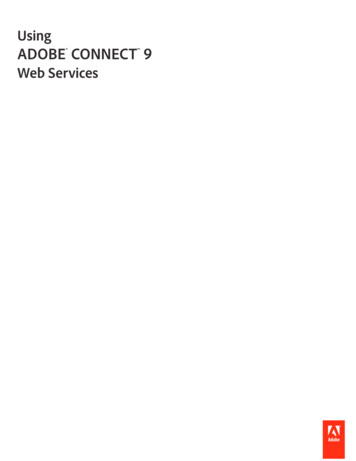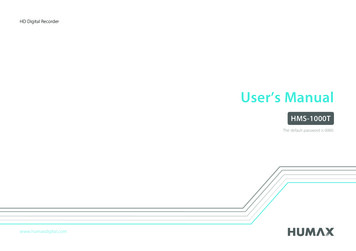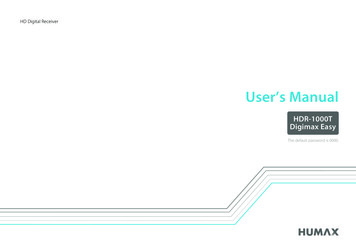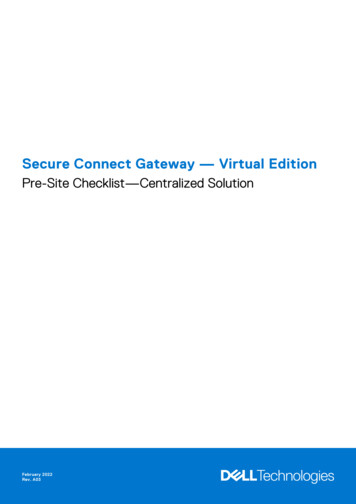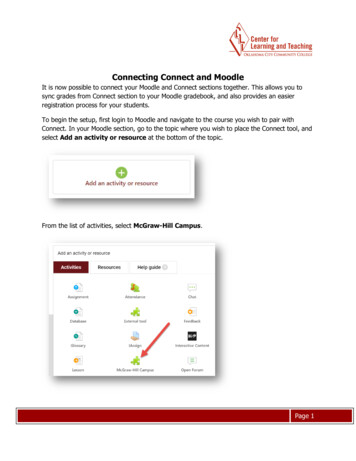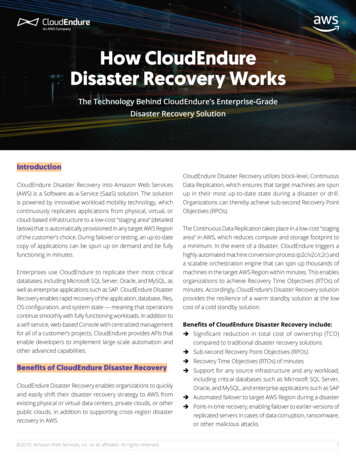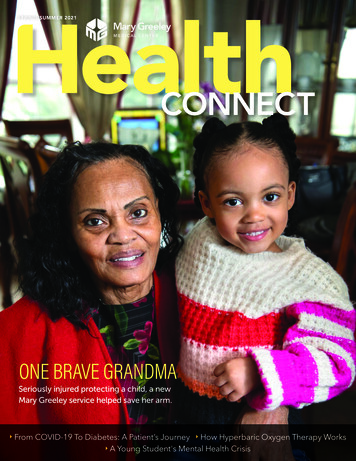
Transcription
SPRING/SUMMER 2021CONNECTONE BRAVE GRANDMASeriously injured protecting a child, a newMary Greeley service helped save her arm. From COVID-19 To Diabetes: A Patient’s Journey How Hyperbaric Oxygen Therapy Works A Young Student's Mental Health Crisis
ContentsSPRING/SUMMER 20212Q&AMary Greeley now has two hyperbaricoxygen therapy chambers. Find out how thistherapy works and who can benefit the mostfrom it.3The ProtectorShe shielded her great-granddaughter froma dog attack, but suffered horrific injuries.Learn more about her heroic act, and howhyperbaric oxygen therapy and a team atMary Greeley helped save her arm.8Thanks COVIDHe was admitted to the hospital with seriousvirus symptoms, only to then learn he haddiabetes. Discover how he faced one illnesswhile learning to manage another with helpfrom our Diabetes and Nutrition Educationinpatient and outpatient services.PLUS: A new program to help peopledealing with food security.10Looking UpAn Iowa State University student with asuicide plan calls a hotline instead and getsthe helps she needs from Mary Greeley, andloving support from her stunned parents.CalendarCOVID-19 has resulted in many Mary Greeleysponsored meetings and events beingcancelled, postponed or delivered remotely.For status on an event, please visit our website,www.mgmc.org/classes.PRESIDENT’S LETTERBy Brian DieterMary Greeley President and CEOHTelling the Storyealthcare Hero. That phrasehas been used throughout theCOVID-19 pandemic. Yet inmost cases, the witnesses to theheroics were the heroes themselves. With strictlimitations on visitors, very few people have haddirect knowledge of what was happening insideour hospital.In November 2020, Mary Greeley MedicalCenter was presented with an opportunity toshow the world what was happening. We wereasked to allow a Des Moines Register reporterand photojournalist to embed on units where wewere treating COVID-19 patients.To our knowledge, no other hospital in the state had done anything like this.It was a situation that needed careful consideration. Would staff in these unitsfeel comfortable with a reporter and photographer observing them, followingthem around for hours at a time? Would patients and families be comfortable?How would we handle privacy issues? The Register team would be onCOVID-19 units; how would we protect them? Did we have enough PPE?We thought through all these issues. We met with the reporter, who assuredus they would respect privacy policies. Most importantly, we surveyed staff,who enthusiastically embraced this opportunity. Nurses, doctors, and othersinvolved in caring for COVID-19 patients wanted this story to be told. Theywanted the public to understand the seriousness of this pandemic. Theywanted the public to understand what frontline healthcare workers wereexperiencing, and what it was like for patients and families.We opted to allow reporter Courtney Crowder and photojournalist ZachBoyden-Holmes to spend a week at Mary Greeley, primarily in the ICUand on our 6th-floor COVID-19 unit. We introduced them to key staff andphysicians, and we suggested several story angles. Then we essentially got outof their way and let them do their thing.Courtney and Zach developed trusting relationships with our staff and thephysicians who were on the frontlines of our COVID-19 response. Theybonded with COVID-19 patients and family members who wanted the storytold as much as hospital staff did.The result was a thoughtfully written, beautifully photographed, and deeplymoving seven-part series called “Inside COVID’s Siege.” The series ran fromJanuary through early March and each story was based at Mary Greeley. Thestories went nationwide, published in other newspapers in the Register’scorporate family. (You can find each story in the series on our website atwww.mgmc.org/COVID-Series.)I have read this series with incredible pride in our staff and the level of care weare providing our patients during an incredibly challenging time. I was foreverVisit us on the internetLearn more about Mary Greeley’s programs and services at www.mgmc.org.President and CEOBrian DieterMedical AdvisorSteven Hallberg, MDContact usIndividuals are encouraged to contact Mary Greeley Medical Center if theyhave any concerns about patient care and safety in the hospital that havenot been addressed. If the concern continues, individuals may contact theIowa Department of Inspections and Appeals, 321 E. 12th St., Des Moines,IA 5319. You may also call 515-281-7102 or e-mail webmaster@dia.aow.gov.Director of Marketingand CommunityRelationsSteve SullivanDesignJessica CarterEditorsSteve SullivanStephanie MarsauPhotographyJustin ConnerTim HoekstraHEALTH CONNECT Spring/Summer 2021 www.mgmc.org
touched by the personal stories shared bypatients and families.I also read this series knowing that we hadcontributed a vital chapter to the history ofCOVID-19 in the state and in the country.The Register series chronicled unforgettablemoments—some touched by joy, someby sorrow. As our COVID-19 numbersstabilize, as more and more people getvaccinated, as warmer days arrive, this seriesserves as a reminder of what we’ve all beenthrough. It is a testament to the value ofcompassion, the strength of families, andthe power of resilience.A photo taken on MaryGreeley’s 6th floor COVID-19unit and featured in the DesMoines Register series. Youcan read all the stories atwww.mgmc.org/COVID-seriesNEW FacesLindsey Rearigh, DOInfectious DiseasesJoined McFarland Clinic: November 2020Dr. Rearigh received her Doctor ofOsteopathic Medicine degree fromEdward Via College of OsteopathicMedicine, Blacksburg, VA. She did aninternal medicine internship and residencyat Mercy Medical Center in Des Moines,and an infectious disease fellowship at theUniversity of Nebraska Medical Center.Jessica Kruckenberg, ARNPHannah Sheridan, PAOncology & HematologyJoined McFarland Clinic: March 2021Sheridan received her B.S. in IntegrativePhysiology from the University of Iowaand Master’s in Healthcare Administrationfrom Kaplan University in Urbandale.She completed her Master’s of PhysicianAssistant Studies at St. Ambrose Universityin Davenport.Anna Statz, DOPsychiatryJoins Mary Greeley: August 2021Kruckenberg received her B.S. in Nursingfrom Allen College. She completed herM.S. in Nursing, Family Nurse Practitionerat Clarkson College.Dr. Statz will treat patients in Mary Greeley’sOutpatient Behavioral Health Clinic Shereceived her Doctor of OsteopathicMedicine from Des Moines UniversityCollege of Osteopathic Medicine. She iscurrently finishing up psychiatry residencyat the University of South Dakota.Aubree Remsburg, CNMJulie Trout DNP, PMHNP-BCOncology & HematologyJoined McFarland Clinic: October 2020Obstetrics & GynecologyJoined McFarland Clinic: February 2021Remsburg received her B.S. in Nursing fromMissouri Southern State University in Joplin,MO. She completed her M.S. in Nursing,Nurse-Midwifery at Frontier NursingUniversity in Hyden, KY.www.mgmc.org Spring/Summer 2021 HEALTH CONNECTPsychiatryJoined Mary Greeley: July 2020Julie Trout treats patients in Mary Greeley’sBehavioral Health Unit. She received herB.S.N. and D.N.P. with specialty inpsychiatry/mental health from the Universityof Iowa.1
Q&AHYPERBARIC OXYGEN THERAPYMary Greeley’s Wound Healing Clinicnow has two hyperbaric oxygen (HBO)therapy chambers, which significantlyexpands the clinic’s ability to do what itdoes best: heal wounds. But how doesit work? Who is it for? What does it haveto do with diving? To learn more, weturned to Mary Lynn Papin, family nursepractitioner with the Wound HealingClinic.How does HBO work?Hyperbaric oxygen therapy has beenused for decades to treat chronicwounds. The patient lies comfortably inthe chamber, which is then pressurized toallow the patient to breathe 100 percentoxygen—compared to normal roomair containing only 21 percent oxygen.This oxygen-rich environment allowsthe lungs to absorb greater amounts ofoxygen, which is delivered by the bloodto the wound or injured area, promotingstronger healing.What are the benefits of the therapy?Many people can benefit from HBOtherapy, especially those living withslow-healing wounds. Hyperbaric oxygentherapy allows your blood to carry moreoxygen to your organs and tissues topromote wound healing by stimulatingthe growth of new blood vessels, tissue,and skin. It also activates the white bloodcells to fight infection and works withantibiotics to make them more effective.What types of wounds or injuries can ittypically treat?HBO therapy is used along with othermedical treatments for slow-healingwounds, diabetic foot ulcers, chronicbone infection, nonhealing surgical skingrafts and flaps, crush injuries, suddenloss of blood flow to an arm or leg, injurycaused by radiation therapy such aspain, wounds, dental problems, rectalbleeding or blood in the urine, certaintypes of sudden hearing loss, suddenvision loss, and even frostbite.2How many sessions might a personneed and how long do they last?Most treatments last about two hoursand are repeated daily (M-F) for 30 ormore sessions. It depends on what typeof wound or injury is being treated.Some patients are going to be waryof therapy. After all, you are puttingthem in a chamber. How do you alleviatethose fears?We start with communication andwalking patients through the journeybefore they are ever placed into thechamber. The chambers have clearacrylic walls, so they feel more openand comfortable. Our hyperbaric nurseand/or medical technologist are alwaysclose by and monitor the entire process.The staff communicates with the patientthrough a microphone, and the patientcan relax and watch TV or movies orlisten to music. It is not uncommonfor patients to sleep throughout theprocedure.Mary Greeley has two chambers. Howwill that benefit our program?The Mary Greeley Wound Healing Clinicis already an established clinic that hasbeen providing excellent wound care.With the addition of the two HBOchambers, our patients can now receivethe care they need without the timeand expense to drive elsewhere. Withtwo chambers, we can treat up to eightpatients a day with HBO therapy.What kind of training did our staff get/need to work with HBO? What is yourbackground with the therapy?The medical staff completed a 40-hourtraining program, which is recognizedby the top two HBO research andmembership organizations—theUndersea and Hyperbaric MedicalSociety and the National Board of Divingand Hyperbaric Medical Technology. Ihave three years of experience and 80 hours of training in HBO therapy. It isa privilege to work with HBO therapypatients and watch them heal.What is the basis for some of theterminology like “dive”?When a patient goes into the chamber,we call it “diving,” and when they aredone, we call it “bringing them up.”There is a historic reason for this. TheUnited States Navy first used HBOtherapy in the 1940s to treat deep-seadivers with decompression sickness.The pressures reached in the chamberare generally between one and a halfand three times greater than normal airpressure, which simulates hyperbaricconditions under the sea—thus the term“diving.”Is the service primarily for outpatientscenarios? Can it be used for emergencysituations?Mary Greeley’s HBO therapy is anoutpatient service. Our clinic operatesMonday through Friday and is not set upfor 24/7 emergency treatment.Is the treatment covered by insurance?Medicare has approved HBO therapyfor many types of chronic nonhealingwounds or injuries. Most privateinsurance companies also approve HBOtherapy when indicated.VIDEOLearn more about hyperbaricoxygen therapy and see it in actionat www.mgmc.org/HBOT.HEALTH CONNECT Spring/Summer 2021 www.mgmc.org
theProtectorVilma Pankey and hergreat-granddaughterCheyera.B Y STEVE SU LLI VANAfter a dog attack, a team at Mary Greeley helps save the armof a heroic grandmother.Hearing that low growl got Vilma Pankey’s attention.Hearing a little girl’s scream got her running.ATTACKThe growl was coming from Pankey’s dog, Thurston,and the scream from her three-year-old greatgranddaughter, Cheyera.Pit bulls have been popular with the Pankey family for along time, and Pankey herself had even taken training for pitowners. There are stereotypes about the breed, though none ofPankey’s dogs had ever given her a problem until now.Pankey, a small woman in her 70s, immediately put herselfbetween Thurston and the girl. What happened next wouldland Pankey in Mary Greeley Medical Center, where a teamof people worked to save her limbs. Part of that collaborativeeffort involved Pankey being the first person at the medicalcenter to receive hyperbaric oxygen (HBO) therapy, a highlyspecialized treatment for wounds.Thurston, who had been a part of the family for six years,usually spent his day staring out a picture window at therabbits bouncing around the yard of Pankey’s rural Ameshome. So, it was a surprise when Thurston started actingaggressive toward Cheyera that January day. Thurston hadbeen around the child before. He was protective of her andeven slept on the floor with her.www.mgmc.org Spring/Summer 2021 HEALTH CONNECT3
“She loved him, and I think he loved her,”said Pankey.Cheyera had just sat down in the livingroom with a lunch of apple slices and aturkey sandwich. Maybe it was the foodthat provoked the dog—who knows?When Pankey heard Cheyera’s scream andran from the kitchen into the living room,she found Thurston threateningly standingin front of the terrified girl.She called out for her husband, whohad just returned home from a medicalprocedure. She then got in betweenThurston and Cheyera, grabbing thegirl by her arm and moving her to safetybehind a chair.That’s when Thurston leapt at her. Pankeyinstinctively raised her arm to protectherself and Thurston locked his jawsaround her right arm.“I was calm,” she said. “I never screamed. Ijust kept talking to him quietly, telling him‘Thurston let go.’ He looked in my eyes as ifasking me, ‘What am I doing? I’m biting mymaster.’ He knew he had screwed up.”Her husband grabbed the dog, whichpulled Pankey down to the floor—Thurstonbetween them. She remained calm and toldher granddaughter, Cheyera’s mom, to geta broomstick. Years ago, Pankey had takena training class for pit bull owners. Shelearned to pry the mouth open, to literallyunlock a dog’s jaw with a stick.She pried Thurston off her arm and beganto move away, but the frightened, confuseddog clamped down on Pankey’s right leg. Heeventually let go but not before doing moredamage to his master. Pankey’s husbandquickly pulled the dog into the garageand then released him into the fenced-inbackyard. (Thurston, not surprisingly, hadto be put down.)Though bleeding, Pankey kept her coolwhile the ambulance arrived. A recentsnow made her driveway impassable for theambulance and she had to be carried out ofher home in a blanket.Members of our Wound Healing Clinic’s hyperbaric oxygen (HBO) therapy team withthe clinic’s two HBO chambers: from right, Mary Lynn Papin, family nurse practitioner;Jake Engelken, EMT, HBO technician; and Donette Tilley, RN, BSN.Not long after arriving at Mary Greeley, shewas in surgery.Her right arm had clinical compartmentsyndrome, the result of the “crush injury”caused by the intense pressure from thedog’s jaws.“This means there is bleeding inside themuscle compartment,” said Dr. BryanWarme, McFarland Clinic orthopedicsurgeon. “The bleeding can’t get out andthat acts as a tourniquet on the arm, cuttingoff blood flow. She had really bad crushinjuries and I had to go in and releasethe compartment to allow it to get bloodflowing again.”Warme performed a fasciotomy, whichinvolves making an incision that cuts openthe skin and fascia, the membrane thatcovers muscles, nerves, and blood vessels.Pankey had open compound fracturesof both leg and arm and Warme had toextensively wash and debride the injuries toreduce the risk of catastrophic infection. Healso splinted the broken bones in Pankey’sarm and leg.SAVING VILMA’S ARMBecause of the extent and the cause of herinjuries, as well as her age, infection was ofsignificant concern.Pankey was brought to Mary Greeley’sEmergency Department with puncturewounds, skin tears, and broken bones in herright arm and leg. These were potentiallylimb-threatening injuries. In other words,due to the extent of the damage, amputationof her severely injured arm and leg was areal possibility.Fortunately, Mary Greeley had recentlyexpanded its Wound Healing Clinic serviceswith the addition of two hyperbaric oxygenchambers. (Read more about HBO therapyon page 2.) Typically, this is an outpatienttreatment, but given the seriousness of thesituation, the care team decided to use it forPankey, an inpatient.4“The timing of the arrival of the chambersand the recognition of it being theappropriate treatment for her injuries wassignificant,” said Mary Lynn Papin, familynurse practitioner with the Wound HealingClinic. “I thought about that every day wewere treating her. Mary Greeley did theright thing.”HEROPankey had wound vacuums, or woundvacs, placed on her arm and leg injuries. Awound vac covers and protects the wound.It removes air pressure from the wound,assisting in healing. It has several otherbenefits, including drawing fluid from thewound, reducing swelling, and helping pulledges of the wound together.Injury to her arteries made Pankey a primecandidate for HBO therapy. Crush injuriesare not unusual in Iowa, and it can takea long time for them to heal—many endup with amputation. HBO can provideimmediate treatment that can help save alimb, such as in the case of Pankey.To do the therapy, Pankey would have tospend extended periods of time in a large,clear chamber. The treatments are called“dives,” a reference to HBO as a longstanding treatment for decompressionsickness that some people can suffer fromscuba diving.Pankey admits to being nervous aboutthe treatment initially. She’d never heardof it before and she was concerned aboutfeeling claustrophobic. Staff informedHEALTH CONNECT Spring/Summer 2021 www.mgmc.org
her that there would always besomeone in the room with her,and that she would be able tocommunicate with peoplewhen inside the chamber.Her family urged her to tryit.“It was an emotionalmoment with her family,”said Papin, a certifiedwound ostomy continencenurse practitioner who hasextensive experience withHBO therapy. “Her twosons were at her side tellingher that she’s here at MaryGreeley and that there’s thisnew therapy.”After displaying all that calmwhile under immense stress,Pankey was now feeling the pain ofher injuries, and feeling afraid.“I told her in that moment that shemight have post-traumatic stress andthat heroes always have it,” Papin said. “Ireally felt and reminded her often that wewere treating a hero. Remember, she put herselfin harm’s way to save her great-granddaughter.”Vilma Pankey gets ready togo into the hyperbaric oxygenchamber with help fromDonette Tilley, RN, BSN, WoundHealing Clinic nurse.INTO THE CHAMBER“When you are in the HBO chamber, you are in an oxygen-richsetting. There is no other environment like it,” said Papin. “It’s apressurized, 100-percent oxygen environment, so your body ispretty much saturated with oxygen.”This was just what Pankey needed. With a crush injury andcompartment syndrome, HBO supplements oxygen availability totissue that has been deprived of oxygen.HBO also helped the wound fight infection prior to the skin graftsurgery on Pankey’s arm, which was performed by Dr. JamesPartridge, a McFarland Clinic surgeon. He executed a splitthickness graft, which involves epidermis (skin) and a portion ofdermis (the material just under the skin).HBO therapy also reduces the risk of a reperfusion injury, whichcan happen post-surgery when blood flow is restored and tissuesswell, potentially crushing damaged blood vessels again.Pankey ultimately did five HBO dives, including one after theskin graft. She spent an average of two hours in the chamber foreach treatment and was typically at what is called 2.4 ATA, oratmosphere absolute, which refers to the amount of pressure onewould undergo at certain depths. A 2.4 ATA is the equivalent ofbeing down approximately 40 feet in seawater.www.mgmc.org Spring/Summer 2021 HEALTH CONNECT“They told me they have this new machine, hyperbaric something,and it looks like a chamber and it will help heal your wounds,”said Pankey, who was an IT tech for the Iowa DOT for 30 years.“It sounded interesting to me, but I’d never seen it before. It was anexperience I could never imagine. It made me feel really relaxed.The longer I was in it the warmer I felt. I fell asleep.”Pankey spent almost two weeks at Mary Greeley and will makereturn visits to ensure her wounds are healing appropriately. Oncehealed, she may need Warme’s skill again to put in plates andscrews on those broken bones.Partridge and Warme are believers in HBO treatment. Pankey “isdoing better that I ever expected,” said Partridge.Warme is a believer in HBO treatment. He experienced it himselfafter a scuba-diving incident where his depth gauge broke and heneeded to take steps to prevent decompression sickness.“I believe in the science. It’s a good therapy,” he said. “We weredoing everything we could for her, and HBO was part of it.” 5
Thanks COVIDBYSTEVE SULLIVANAfter being hospitalized with the virus, Matt Femrite learnedhe was facing another equally serious health issue.Matt Femrite knew he hadCOVID-19.Greeley’s Diabetes and Nutrition EducationCenter, Haveman has seen a lot of this.It was when his symptomslanded him in Mary Greeley’sEmergency Department that he received adiagnosis that would change his life.”“How are you managing your diabetes?”asked Dr. Andrew Boyko, the McFarlandClinic emergency medicine physician whotreated him.“What?” thought Femrite.“Diabetes?”Dealing with a severe case ofCOVID-19 was tough enough, andnow Femrite had to face managinglife with diabetes. Mary Greeley’shighly skilled and coordinatedinpatient and outpatient diabetes careteam was ready to help.A POSSIBILITYThe news wasn’t a total surprise,Femrite admits. Two decades earlier,his father had been diagnosed withdiabetes, and he recently learnedthat the disease has been present inseveral generations of his family.“I’m a poster child for bad genetics,”said Femrite, who was diagnosedwith type 2 diabetes, meaninghis body doesn’t produce enoughinsulin to manage the glucose in hisbloodstream.“There were things that made me wonder,but at the same time, ignorance is bliss,” headded. “If I don’t have a diagnosis, I don’thave to deal with it. How bad could it be?Dealing with it has made all the difference.”Femrite had been living with what SarahHaveman calls “deniabetes.” A registereddietitian and diabetes educator with Mary6“Deniabetes refers to someone choosingto deny they have diabetes rather thanface the diagnosis and make changes tomanage it,” she said. “Matt had been livingwith deniabetes, but since getting an actualdiagnosis, he has worked hard and so farsuccessfully to turn things around.”"These tools I use tomanage my diabetesallow me to have morecontrol over it withgreater precision,convenience, andsafety,” Matt said.COVIDFemrite came down with COVID-19symptoms—fever, cough, fatigue—inearly September. Both he and his wifeended up testing positive for the virus. Alegal analyst for the state of Iowa, Femriteworks from home. His wife, Stephanie, isan Iowa State student.“We took all the precautions,” he said.“When I run errands, I wear a mask andsocial distance. My wife attends classes oncampus, but she had never been contactedby a contact tracer.”Not long after the initial diagnosis, hissymptoms got worse.“The first time we went to the hospital, hisoxygen levels weren’t low enough to keephim, so they gave him a list ofsymptoms to watch for in case heneeded to come back. He had beenfeeling better for a couple of days,and then on that Friday he gotworse,” said Stephanie. “Towardthe end of the day, Matt was tryingto talk to me about something andhe couldn’t say more than a fewwords at a time without needing tobreathe. The hospital said to bringhim back if he couldn’t say morethan four words together.”Femrite was admitted to MaryGreeley’s COVID-19 unit. Hespent five days in the hospital,including several on oxygen.Because of visitor policies relatedto COVID-19,Stephanie couldn’t visither husband.“We did video calls,which was helpful. Thesense of isolation washard, though. Evenwhen people came in,they wore masks andface shields,” Femritesaid. “I rememberjoking that my wife has COVID anyway,why can’t she visit? I’m already paying forthe room. She could sleep on the couch.”HEALTH CONNECT Spring/Summer 2021 www.mgmc.org
Matt and StephanieFemrite enjoy a healthywalk at Ada HaydenPark in Ames. Bothexperienced COVID-19and both have beendiagnosed with diabetes.While he was able to joke at times, Femritewas dealing with a lot of emotions. He wasin the hospital with COVID-19. He wasworried about Stephanie, who was homealone, coping with the virus herself andkeeping up with school.“It was a nightmare scenario,” he said. “Wewere both sick and I wasn’t there with her.”And then there was that question that stillneeded attention: “How are you managingyour diabetes?”COORDINATED DIABETESCAREOn an average day, Mary Greeley has 100–105 admitted patients. Typically, 30–35 ofthese patients have a diabetes diagnosis.This creates a significant need for inpatientdiabetes care services. Enter KimberlyCase, a family care nurse practitioner whocollaborates with doctors and hospital staffon inpatient diabetes care.Case met with Femrite while he was in thehospital—via iPad due to COVID-19 safetymeasures.“Each patient is individual, but he wasvery motivated to get his diabetes undercontrol,” she said.with Haveman as an outpatient, coveringsuch topics as good nutrition and trackinggrams of carbohydrates per meal.“He needed basic education on his newdiagnosis, as well as education on insulinadministration and insulin adjustment,”she said. “We want them to be successfulwhen they go home, so helping with thesetopics while they are an inpatient is verybeneficial.”GADGETSCase made sure he knew how to givehimself an insulin shot. COVID-19treatment ironically provided anopportunity to educate about insulinadjustment. Steroids used to treat virussymptoms can cause higher levelsof glucose in the blood. This meantadjustments were needed for his insulindosage while on virus-fighting steroids.To further ensure Femrite’s post-dischargesuccess, Case connected him withHaveman (who also met with Femritevia iPad), helping him understanddiabetes management, including insulinadministration and checking bloodsugars. He continued to have meetingswww.mgmc.org Spring/Summer 2021 HEALTH CONNECTFemrite went home, checking his glucoselevels four times a day with a glucosemonitor and giving himself insulininjections four times a day. He did someresearch on insulin pumps and opted to getone not long after his discharge.An admitted tech nerd, Femrite did a deepdiabetes dive and has embraced all thediabetes management tools now available.He even made a spreadsheet of diabetessymptoms, tracking when he first recalledexperiencing them over the years. Frequenturination? Check. Slow healing? Check.Hunger? Check. Sticky urine? Check.(That’s because of the sugar in the urine.An early test for diabetes, dating back toancient times, involved tasting urine forsweetness. Medicine has come a long waysince then.)“He likes the toys, the technology,” saidHaveman.7
Femrite now uses a glucose monitor that sends glucose data tohis insulin pump and can increase or decrease the drip of insulinas needed. An app enables Femrite to view his data on his phone.The app also uploads Femrite’s stats to his MyChart records, whereHaveman can review them if needed.“These tools I use to manage my diabetes allow me to have morecontrol over it with greater precision, convenience, and safety,” hesaid. “For example, my CGM (continuous glucose monitor) allowsme to see if I’m experiencing an unexpected high or low. Thisallows me to treat blood glucose variations as they happen, whichhelps me keep my blood glucose within a tighter range. Similarly,my insulin pump lets me directly manage my glucose levels in realtime. However, my pump also automatically varies my basal insulinbased on my glucose levels. This feature has all but eliminatedepisodes of hypoglycemia and hyperglycemia with less interventionon my part.”His enthusiasm and commitment have paid off. When diagnosed,his A1C (a measurement of glucose in the bloodstream) was 12.6percent. Three months later, it was 6.3 percent. The normal range isjust under 7 percent.“That is a crazy good drop. It indicates huge glucose managementimprovement,” said Haveman.DIABETES FOR 2Femrite is eating better these days and paying particular attentionto portions. It’s all about moderation, more than denial. Still, headmits to missing those beloved hungry-man helpings of macaroniand cheese.He also plans to get back on his bike. He was an avid cyclist, butlaw school derailed that pastime. He plans to get back on thebike now, knowing that exercise is also a key element of diabetesmanagement.Remember how Femrite and his wife both had COVID? They bothnow have diabetes as well. She was diagnosed early last year withtype 2 diabetes and manages it with medication, diet, and exercise.But sharing a similar diagnosis has brought them closer together.“Obviously, neither of us being diabetic would be optimal, but it’sless lonely that we both share the same condition. We get to act aseach other’s support system. It’s much easier to plan meals sincewe have the same restrictions. It’s easier to stay on track both withdiet and exercise when there’s someone else who understands thetemptations to just let things go. It’s great to have that extra level ofboth support and accountability.” “I feel better than I have in a long time,” he said.Kimberly Case, familynurse practitioner,and Sarah Hav
from Kaplan University in Urbandale. She completed her Master's of Physician Assistant Studies at St. Ambrose University in Davenport. Anna Statz, DO Psychiatry Joins Mary Greeley: August 2021 Dr. Statz will treat patients in Mary Greeley's Outpatient Behavioral Health Clinic She received her Doctor of Osteopathic Medicine from Des Moines University College of Osteopathic Medicine. She is .

